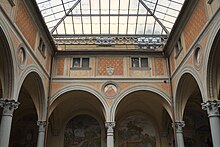Santissima Annunziata, Florence
Though the structure was refurbished in Baroque-style in the seventeenth century, the basic scheme of a domed circular space flanked by altar niches is still evident.Pilgrims who came to the church to venerate the miraculous painting often left wax votive offerings, many of them life-size models of the donor (sometimes complete with horses).Pope Alexander VI, in appreciation for the survival of Rome after French occupation, paid homage and gifted a silver effigy to the church.The Baroque decoration of the church interior was begun in 1644, when Pietro Giambelli frescoed the ceiling with an Assumption as a centerpiece based on designs by Baldassare Franceschini.The chapel-surrounded tribune or choir, known as the Rotonda, was designed in turn by Michelozzo and Alberti between 1444 and 1476. Notable among the chapels is the fifth (aligned to nave axis), which has a crucifix (1594–8) by Giambologna for his tomb, with statues of the "Active and Contemplative Lives" by his pupil Francavilla, saints and angels by Pietro Tacca,[5] and murals by Bernardino Poccetti.The Capella di San Luca, which opens off it, has belonged to the artists confraternity or the Accademia delle Arti del Disegno since 1565.In 2007, in the west part of the cloister occupied by the Istituto, the group found a monumental stair by Michelozzo, previously hidden, an Annunciation attributed to Paolo Uccello,[citation needed] and some 'Grottesche' frescoes by Morto da Feltre.




Istituto Statale della Santissima AnnunziataRenaissanceCatholicminor basilicaFlorenceTuscanymother churchServite OrderPiazza Santissima AnnunziataAnnunciationGonzagaMantuaMichelozzoLudovico III GonzagaLeon Battista AlbertiBaroqueGiovanni Battista CacciniBrunelleschiFoundling HospitalSangallo the ElderPope Alexander VIBaldassare FranceschiniJacopo da EmpoliMatteo RosselliBernardo RossellinoBaccio BandinelliAlbertiGiambolognaFrancavillaPietro TaccaBernardino PoccettiBronzinoVeit StossPeruginoRaffaellino del GarboAnnunziata AltarpieceGallerie dell'AccademiaAndrea del CastagnoGianbattista FogginiPagno di Lapo PortigianiSimone StellaMaria ValtortaGiovanna Tacconi MessiniAndrea FeltrinoFilippo BenizziAndrea del SartoAssumptionRosso FiorentinoVisitationPontormoMarriage of the VirginFranciabigioBirth of the VirginS. Filippo BeniziCosimo RosselliAlesso BaldovinettiMadonna del Saccodel SartoCapella di San LucaAccademia delle Arti del DisegnoBenvenuto CelliniGiovanni Angelo MontorsoliLorenzo BartoliniAlessandro AlloriVasariSanti di TitoVincenzo DantiMontorsoliIstituto Geografico MilitarePaolo UccelloMorto da FeltreFranco BorsiRafael SabatiniTempio Malatestiano, RiminiSanta Maria Novella, FlorenceSan Sebastiano, MantuaSant'Andrea, MantuaPalazzo Rucellai, FlorenceRucellai SepulchreSan Pancrazio, FlorenceDe picturaDe re aedificatoriaAlberti cipherThe Age of the MediciTourismMuseumsBargelloCasa BuonarrotiCasa GuidiGalleria dell'AccademiaGarden of ArchimedesLoggia del BigalloLoggia dei LanziLoggia del Mercato NuovoLoggia del PesceLoggia RucellaiMuseo dell'Opera del DuomoMuseo GalileoMuseo Nazionale Alinari della FotografiaMuseo Nazionale di San MarcoMuseo di Storia Naturale di FirenzeLa SpecolaNational Archaeological MuseumOrsanmicheleOspedale degli InnocentiPalazzo dell'Arte dei BeccaiPalazzo DavanzatiPalazzo Della StufaPalazzo GondiPalazzo Medici RiccardiMagi ChapelPalazzo PittiMuseo delle PorcellanePalazzo Spini FeroniPalazzo StrozziPalazzo VecchioStudiolo of Francesco IStibbert MuseumUffiziVasari CorridorCathedral of Santa Maria del FioreS CroceBaroncelli ChapelPazzi ChapelS LorenzoMedici Chapels